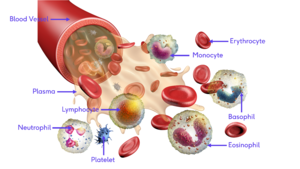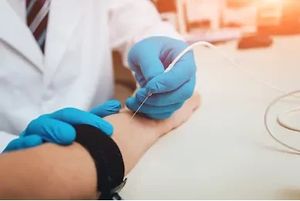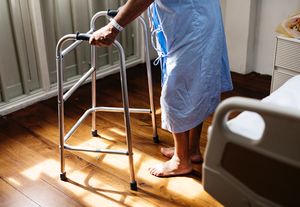Neutropenia: Difference between revisions
Chloe Waller (talk | contribs) m (spacing) |
Chloe Waller (talk | contribs) (Corrected references) |
||
| Line 5: | Line 5: | ||
== Introduction == | == Introduction == | ||
Neutropenia is a low level of neutrophils in the blood<ref>Copeland et al. [https://bestpractice.bmj.com/topics/en-gb/893 Assessment of Neutropenia]. BMJ. 2021</ref>. Neutrophils are a type of white blood cell, that support the immune system to fight injection by ingesting and killing invading microorganisms<ref>Justiz Vaillant AA, Zito PM. [https://pubmed.ncbi.nlm.nih.gov/29939524/ Neutropenia]. 2021 Nov 15. In: StatPearls [Internet]. Treasure Island (FL): StatPearls Publishing; 2022 | Neutropenia is a low level of neutrophils in the blood<ref>Copeland et al. [https://bestpractice.bmj.com/topics/en-gb/893 Assessment of Neutropenia]. BMJ. 2021</ref>. Neutrophils are a type of white blood cell, that support the [[Immune System|immune system]] to fight injection by ingesting and killing invading microorganisms<ref>Justiz Vaillant AA, Zito PM. [https://pubmed.ncbi.nlm.nih.gov/29939524/ Neutropenia]. 2021 Nov 15. In: StatPearls [Internet]. Treasure Island (FL): StatPearls Publishing; 2022 Jan</ref>. Neutropenia is defined as less than 1500 neutrophils per micro-litre of blood. It can be classed as mild (1000 to 1500 neutrophils per micro-litre), moderate (500 to 1000 neutrophils per micro-litre) or severe (less than 500 neutrophils per micro-litre)<ref name=":0">Schwartzberg LS. [https://pubmed.ncbi.nlm.nih.gov/17379162/ Neutropenia: etiology and pathogenesis]. Clin Cornerstone. 2006;8 Suppl 5:S5-11</ref>. Neutropenia leads to an increased risk of infection and this risk is directly correlated with how long a patient has been neutropenic and how severe the neutropenia is. <ref name=":0" />. | ||
[[File:Blood with description.png|thumb]] | [[File:Blood with description.png|thumb]] | ||
== Aetiology == | == Aetiology == | ||
Neutropenia can develop due to a wide range of one or more causes<ref>Frater JL. [https://pubmed.ncbi.nlm.nih.gov/32543073/ How I investigate neutropenia]. Int J Lab Hematol. 2020 Jun;42 Suppl 1:121-132 | Neutropenia can develop due to a wide range of one or more causes<ref>Frater JL. [https://pubmed.ncbi.nlm.nih.gov/32543073/ How I investigate neutropenia]. Int J Lab Hematol. 2020 Jun;42 Suppl 1:121-132</ref>. | ||
Neutropenia can be caused by<ref>Christopher Gibson, Nancy Berliner; [https://ashpublications.org/blood/article/124/8/1251/33512/How-we-evaluate-and-treat-neutropenia-in-adults How we evaluate and treat neutropenia in adults]. Blood 2014; 124 (8): 1251–1258. | Neutropenia can be caused by<ref>Christopher Gibson, Nancy Berliner; [https://ashpublications.org/blood/article/124/8/1251/33512/How-we-evaluate-and-treat-neutropenia-in-adults How we evaluate and treat neutropenia in adults]. Blood 2014; 124 (8): 1251–1258.</ref>: | ||
* <span class="s2"></span>Congenital neutropenia | * <span class="s2"></span>Congenital neutropenia | ||
* <span class="s2"></span>Infection | * <span class="s2"></span>Infection | ||
* <span class="s2"></span>Medicine, including [[Chemotherapy Side Effects and Syndromes|Chemotherapy]] | * <span class="s2"></span>Medicine, including [[Chemotherapy Side Effects and Syndromes|Chemotherapy]] | ||
* <span class="s2"></span>Autoimmune response | * <span class="s2"></span>[[Autoimmune Disorders|Autoimmune]] response | ||
* <span class="s2"></span>Malignancy | * <span class="s2"></span>[[Oncology|Malignancy]] | ||
* <span class="s2"></span>Dietary deficiencies | * <span class="s2"></span>Dietary deficiencies | ||
| Line 24: | Line 24: | ||
== Clinical Presentation == | == Clinical Presentation == | ||
Neutropenia itself is asymptomatic until an infection develops, whereby [[fever]] is the primary symptom<ref name=":2">M. Territo. [https://www.msdmanuals.com/professional/hematology-and-oncology/leukopenias/neutropenia Neutropenia]. MSD Manual Professional Edition. 2021</ref>. Usual signs of inflammation and infection can occur but may be reduced in neutropenic patients, due to the reduced immune response<ref name=":1">A. Urabe, [https://academic.oup.com/cid/article/39/Supplement_1/S53/401452 Clinical Features of the Neutropenic Host: Definitions and Initial Evaluation], Clinical Infectious Diseases, Volume 39, Issue Supplement_1, July 2004, Pages S53–S55 | Neutropenia itself is asymptomatic until an infection develops, whereby [[fever]] is the primary symptom<ref name=":2">M. Territo. [https://www.msdmanuals.com/professional/hematology-and-oncology/leukopenias/neutropenia Neutropenia]. MSD Manual Professional Edition. 2021</ref>. Usual signs of inflammation and infection can occur but may be reduced in neutropenic patients, due to the reduced immune response<ref name=":1">A. Urabe, [https://academic.oup.com/cid/article/39/Supplement_1/S53/401452 Clinical Features of the Neutropenic Host: Definitions and Initial Evaluation], Clinical Infectious Diseases, Volume 39, Issue Supplement_1, July 2004, Pages S53–S55 </ref>. | ||
[[File:Needle EMG.jpg|thumb]] | [[File:Needle EMG.jpg|thumb]] | ||
| Line 32: | Line 32: | ||
* Physical examination for focal symptoms<ref name=":2" />. | * Physical examination for focal symptoms<ref name=":2" />. | ||
* Full blood count including creatinine and CRP<ref name=":1" />. | * Full blood count including creatinine and CRP<ref name=":1" />. | ||
* Chest radiography for patients with respiratory symptoms<ref name=":1" />. | * Chest [[X-Rays|radiography]] for patients with [[Respiratory Disorders|respiratory symptoms]]<ref name=":1" />. | ||
* Bacteria and fungi cultures<ref name=":1" />. | * Bacteria and fungi cultures<ref name=":1" />. | ||
== Management == | == Management == | ||
* <span class="s1"></span>Antibiotics: timely administration when a patient is febrile significantly improves mortality rate<ref>Peyrony O, Gerlier C, Barla I, Ellouze S, Legay L, Azoulay E, | * <span class="s1"></span>[[Antibiotics]]: timely administration when a patient is febrile significantly improves mortality rate<ref>Peyrony O, Gerlier C, Barla I, Ellouze S, Legay L, Azoulay E, et al. [https://pubmed.ncbi.nlm.nih.gov/32109264/ Antibiotic prescribing and outcomes in cancer patients with febrile neutropenia in the emergency department]. PLoS One. 2020 Feb 28;15(2):e0229828</ref><ref>Sharma A, Lokeshwar N. [https://www.jpgmonline.com/article.asp?issn=0022-3859;year=2005;volume=51;issue=5;spage=42;epage=48;aulast=Sharma Febrile neutropenia in haematological malignancies]. J Postgrad Med. 2005;51 Suppl 1:S42-8.</ref><ref>National Institute for Health and Care Guideline (2020) [https://www.nice.org.uk/guidance/cg151/evidence/full-guideline-188303581 Neutropenic sepsis: prevention and management of neutropenic sepsis in cancer patients.]</ref>. | ||
* <span class="s1"></span>Intervention to treat the underlying cause of the neutropenia<ref name=":3">Tim Newman. [https://www.medicalnewstoday.com/articles/265373 What’s to know about neutropenia?] From: Medical New Today. 2017</ref>. | * <span class="s1"></span>Intervention to treat the underlying cause of the neutropenia<ref name=":3">Tim Newman. [https://www.medicalnewstoday.com/articles/265373 What’s to know about neutropenia?] From: Medical New Today. 2017</ref>. | ||
* <span class="s1"></span>Granulocyte-colony stimulating factor (G-CSF): stimulates the bone marrow to produce neutrophils<ref name=":3" />. | * <span class="s1"></span>Granulocyte-colony stimulating factor (G-CSF): stimulates the bone marrow to produce neutrophils<ref name=":3" />. | ||
| Line 44: | Line 44: | ||
== Implications for Physiotherapy == | == Implications for Physiotherapy == | ||
[[File:Walking frame.jpg|thumb]] | [[File:Walking frame.jpg|thumb]] | ||
There are no specific exercise recommendations for patients with neutropenia, and their full clinical presentation needs to be considered<ref>Jeevanantham D, Rajendran V, Tremblay L, Larivière C, Knight A. [https://systematicreviewsjournal.biomedcentral.com/articles/10.1186/s13643-018-0785-7 Evidence-based guidelines for physiotherapy management of patients with multiple myeloma: Study protocol]. ''Syst Rev''. 2018 | There are no specific exercise recommendations for patients with neutropenia, and their full clinical presentation needs to be considered<ref>Jeevanantham D, Rajendran V, Tremblay L, Larivière C, Knight A. [https://systematicreviewsjournal.biomedcentral.com/articles/10.1186/s13643-018-0785-7 Evidence-based guidelines for physiotherapy management of patients with multiple myeloma: Study protocol]. ''Syst Rev''. 2018</ref>. Because of the increased risk of infection, patients should be treated following strict infection control guidelines – this includes patient and therapist wearing face masks, regular hand hygiene and sanitisation of equipment, and treating patients inside their room instead of in communal areas where possible<ref>D. Jeevanantham, V. Rajendran, Z. McGillis, L. Tremblay, C. Larivière,, A. Knight, [https://academic.oup.com/ptj/article/101/1/pzaa180/5911069 Mobilization and Exercise Intervention for Patients With Multiple Myeloma: Clinical Practice Guidelines Endorsed by the Canadian Physiotherapy Association], Physical Therapy, Volume 101, Issue 1, January 2021</ref>. | ||
Revision as of 12:19, 25 April 2022
Introduction[edit | edit source]
Neutropenia is a low level of neutrophils in the blood[1]. Neutrophils are a type of white blood cell, that support the immune system to fight injection by ingesting and killing invading microorganisms[2]. Neutropenia is defined as less than 1500 neutrophils per micro-litre of blood. It can be classed as mild (1000 to 1500 neutrophils per micro-litre), moderate (500 to 1000 neutrophils per micro-litre) or severe (less than 500 neutrophils per micro-litre)[3]. Neutropenia leads to an increased risk of infection and this risk is directly correlated with how long a patient has been neutropenic and how severe the neutropenia is. [3].
Aetiology[edit | edit source]
Neutropenia can develop due to a wide range of one or more causes[4].
Neutropenia can be caused by[5]:
- Congenital neutropenia
- Infection
- Medicine, including Chemotherapy
- Autoimmune response
- Malignancy
- Dietary deficiencies
Clinical Presentation[edit | edit source]
Neutropenia itself is asymptomatic until an infection develops, whereby fever is the primary symptom[6]. Usual signs of inflammation and infection can occur but may be reduced in neutropenic patients, due to the reduced immune response[7].
Diagnostic Procedures[edit | edit source]
- Subjective assessment to get full medical history[8].
- Physical examination for focal symptoms[6].
- Full blood count including creatinine and CRP[7].
- Chest radiography for patients with respiratory symptoms[7].
- Bacteria and fungi cultures[7].
Management[edit | edit source]
- Antibiotics: timely administration when a patient is febrile significantly improves mortality rate[9][10][11].
- Intervention to treat the underlying cause of the neutropenia[12].
- Granulocyte-colony stimulating factor (G-CSF): stimulates the bone marrow to produce neutrophils[12].
- Basic lifestyle modifications are advised to reduce risk of infection[12].
Implications for Physiotherapy[edit | edit source]
There are no specific exercise recommendations for patients with neutropenia, and their full clinical presentation needs to be considered[13]. Because of the increased risk of infection, patients should be treated following strict infection control guidelines – this includes patient and therapist wearing face masks, regular hand hygiene and sanitisation of equipment, and treating patients inside their room instead of in communal areas where possible[14].
References[edit | edit source]
- ↑ Copeland et al. Assessment of Neutropenia. BMJ. 2021
- ↑ Justiz Vaillant AA, Zito PM. Neutropenia. 2021 Nov 15. In: StatPearls [Internet]. Treasure Island (FL): StatPearls Publishing; 2022 Jan
- ↑ 3.0 3.1 Schwartzberg LS. Neutropenia: etiology and pathogenesis. Clin Cornerstone. 2006;8 Suppl 5:S5-11
- ↑ Frater JL. How I investigate neutropenia. Int J Lab Hematol. 2020 Jun;42 Suppl 1:121-132
- ↑ Christopher Gibson, Nancy Berliner; How we evaluate and treat neutropenia in adults. Blood 2014; 124 (8): 1251–1258.
- ↑ 6.0 6.1 M. Territo. Neutropenia. MSD Manual Professional Edition. 2021
- ↑ 7.0 7.1 7.2 7.3 A. Urabe, Clinical Features of the Neutropenic Host: Definitions and Initial Evaluation, Clinical Infectious Diseases, Volume 39, Issue Supplement_1, July 2004, Pages S53–S55
- ↑ Dale DC. How I diagnose and treat neutropenia. Curr Opin Hematol. 2016 Jan;23(1):1-4. doi: 10.1097/MOH.0000000000000208. PMID: 26554885; PMCID: PMC4668211.
- ↑ Peyrony O, Gerlier C, Barla I, Ellouze S, Legay L, Azoulay E, et al. Antibiotic prescribing and outcomes in cancer patients with febrile neutropenia in the emergency department. PLoS One. 2020 Feb 28;15(2):e0229828
- ↑ Sharma A, Lokeshwar N. Febrile neutropenia in haematological malignancies. J Postgrad Med. 2005;51 Suppl 1:S42-8.
- ↑ National Institute for Health and Care Guideline (2020) Neutropenic sepsis: prevention and management of neutropenic sepsis in cancer patients.
- ↑ 12.0 12.1 12.2 Tim Newman. What’s to know about neutropenia? From: Medical New Today. 2017
- ↑ Jeevanantham D, Rajendran V, Tremblay L, Larivière C, Knight A. Evidence-based guidelines for physiotherapy management of patients with multiple myeloma: Study protocol. Syst Rev. 2018
- ↑ D. Jeevanantham, V. Rajendran, Z. McGillis, L. Tremblay, C. Larivière,, A. Knight, Mobilization and Exercise Intervention for Patients With Multiple Myeloma: Clinical Practice Guidelines Endorsed by the Canadian Physiotherapy Association, Physical Therapy, Volume 101, Issue 1, January 2021









